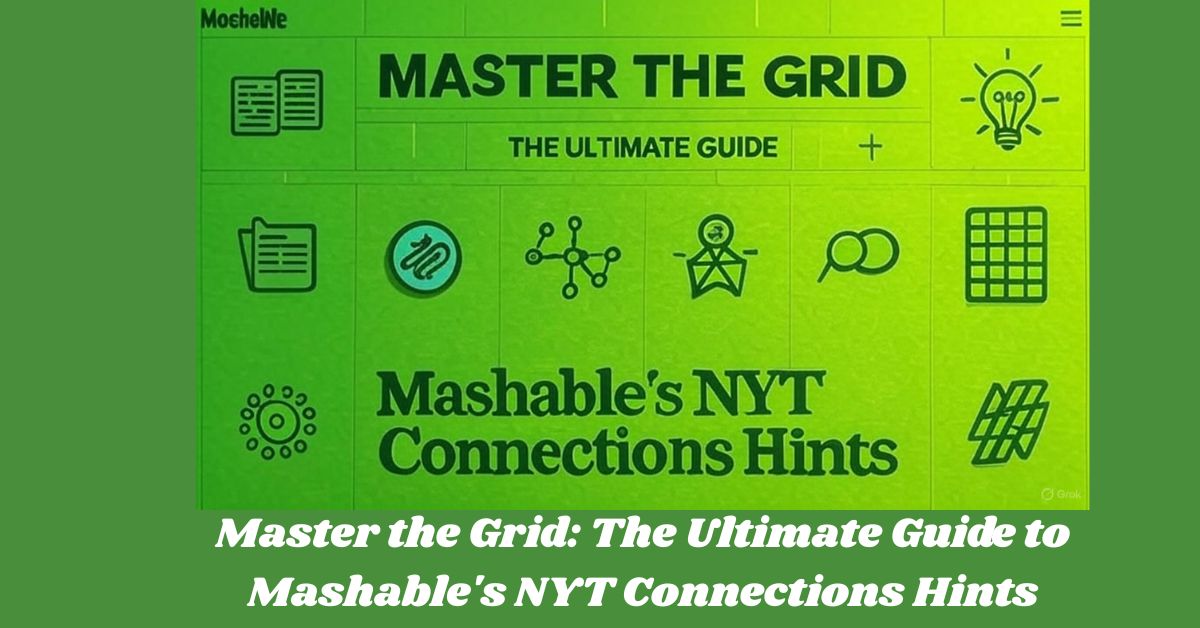NYT Connections has rapidly become one of the most popular word puzzles since its 2023 launch. The puzzle challenges players to sort 16 words into four distinct categories. Created by puzzle master Wyna Liu, this game tests your ability to think laterally and identify patterns. Unlike linear puzzles, Connections requires you to find relationships between seemingly unrelated words.
The game appeals to our natural desire to categorize and find patterns. Daily puzzles reset at midnight Eastern Time. Each puzzle has a unique number for reference. NYT Connections quickly joined Wordle and the NYT Crossword as a daily ritual for word game enthusiasts.
The color coding system serves as both difficulty indicator and scoring guide:
- Yellow (easiest): Worth 1 point
- Green (medium): Worth 2 points
- Blue (challenging): Worth 3 points
- Purple (most difficult): Worth 4 points
Decoding the Connections Puzzle Format
The game presents a 4×4 grid containing 16 words for players to sort. Your task is to group these into four categories of four words each. This simple concept requires significant mental effort to execute properly.
Common patterns found in puzzles include:
- Word forms (words that can be paired with another word)
- Thematic groupings (items belonging to a larger category)
- Linguistic tricks (homophones, double meanings, or puns)
- Cultural references (movie titles, song lyrics, or famous quotes)
Players are limited to four incorrect attempts. This restriction creates the perfect environment for hint systems to flourish. When faced with difficult puzzles, many players turn to Mashable for assistance.
The game’s difficulty progression through colors helps players prioritize which groups to identify first. Yellow categories typically feature obvious groupings like animals or foods. Purple categories often involve obscure or punny connections that require creative thinking.
Mashable’s Approach to Connections Hints
Mashable has developed a sophisticated system for providing NYT Connections hints. Their approach balances assistance with preservation of the solving experience. The tiered hint system offers progressively more revealing clues without spoiling the entire puzzle.
Mashable’s hint structure includes:
- Category hints (vague descriptions of connections)
- Word pattern hints (specific guidance about relationships)
- Partial answers (one or two words from each category)
- Complete solutions (full answers for those truly stuck)
This graduated approach lets players choose their level of assistance. You can take just enough help to get unstuck without ruining the puzzle. Mashable’s update schedule is remarkably consistent, with new hints appearing within hours of each puzzle’s release.
Compared to official NYT hints, Mashable offers a more comprehensive system. While NYT typically provides only one level of hint, Mashable’s approach suits both beginners and experienced players. This flexibility has made Mashable the go-to resource for Connections players.
Breaking Down Mashable’s Hint Structure
Category clues form the foundation of Mashable’s hint system. These cleverly worded descriptions point toward the theme without giving it away completely. For example, rather than directly stating “Types of birds,” Mashable might say “These creatures might visit your backyard feeder.”
Word pattern hints dig deeper, often highlighting structural elements:
- “Words that can follow ‘snow'”
- “Things you might find in a kitchen”
- “Words containing double letters”
Mashable’s visual presentation enhances accessibility through:
- Bold text for category hints
- Color-coded sections matching the game’s difficulty levels
- Collapsible sections to prevent accidental spoilers
This format allows readers to gradually reveal more information as needed. It’s particularly helpful on mobile devices, where many players access hints. Unique to Mashable is their “hint map” approach, visualizing relationships between categories and showing where overlaps might cause confusion.
The progressive nature of Mashable’s hints helps players develop their own solving skills over time. By starting with vague hints and gradually becoming more specific, players can challenge themselves appropriately.
Real Examples of Mashable Hints in Action

Yellow Category Example (Easiest)
For a yellow category containing words like APPLE, CHERRY, LEMON, and ORANGE, Mashable’s hint progression might look like:
- Category Hint: “These items might be found in a produce section”
- Word Pattern Hint: “They all grow on trees”
- Partial Answer: “APPLE and ORANGE belong in this group”
This example demonstrates how Mashable gradually narrows the focus. The first hint points to food items generally. The second hint eliminates vegetables. The partial answer confirms the pattern of tree fruits.
Purple Category Example (Hardest)
For a purple category with words like FLIES, LIES, PIES, and TIES, Mashable’s approach becomes more nuanced:
- Category Hint: “Look closely at what these words have in common”
- Word Pattern Hint: “Consider how these words are pronounced”
- Word Pattern Hint 2: “These words all rhyme with ‘eyes'”
- Partial Answer: “FLIES and TIES belong in this group”
This example shows how Mashable handles the most challenging connections. The hints progressively guide players toward recognizing the phonetic pattern without immediately giving away the answer.
Difficult Mixed Case
For a blue category containing words like CAST, EDITION, MOLD, and STAMP, Mashable might provide:
- Category Hint: “Think about creating multiple copies”
- Word Pattern Hint: “These words can all function as verbs”
- Word Pattern Hint 2: “These all relate to manufacturing processes”
- Partial Answer: “CAST and MOLD belong in this group”
This example highlights how Mashable handles words with multiple meanings. The hints help players focus on the specific definition relevant to the connection, in this case words related to making duplicates or copies.
READ THIS BLOG : 25+ RIP Condolence Messages to Offer Comfort
Advanced Techniques for Puzzle Solving
Beyond using Mashable’s hints, there are sophisticated strategies that top Connections players employ. These techniques can help you solve puzzles faster and with fewer hints.
Pattern recognition strategies involve looking for common structures:
- Word length patterns (Are all words in a group the same length?)
- Part of speech patterns (Are they all verbs, nouns, or adjectives?)
- Prefix/suffix patterns (Do they share common beginnings or endings?)
Word association techniques can uncover less obvious connections:
- Try creating sentences using each word in the same position
- Consider idiomatic expressions containing the words
- Think about cultural contexts where these words appear together
Elimination methods work backward to solve puzzles:
- Identify the most obvious group first
- Remove those words from consideration
- Look for patterns among remaining words
- Repeat until all groups are identified
Dealing with deliberately misleading connections is a crucial skill. NYT Connections often includes red herrings words that seem to fit in multiple categories. The most challenging puzzles create false patterns that lead players down incorrect paths.
When and How to Use Mashable’s Hints Effectively
Strategic hint usage can enhance your puzzle-solving skills over time. The progressive hint strategy works like this:
- Attempt the puzzle completely on your own first
- If stuck after two incorrect guesses, check category hints only
- Make another attempt based on these hints
- If still stuck, check word pattern hints
- Only check partial or complete answers as a last resort
Identifying mental roadblocks helps determine when hints are appropriate:
- Fixation block: When you can’t see beyond an incorrect pattern
- Vocabulary block: When words have meanings unknown to you
- Conceptual block: When the category itself is unfamiliar
Learning from hint patterns improves your skills for future puzzles:
- Notice which categories consistently trip you up
- Pay attention to recurring themes in Mashable’s hints
- Keep a puzzle journal tracking which hints were most helpful
Building your solving intuition comes from mindful practice:
- After using hints, replay the puzzle mentally
- Identify where your thinking went wrong
- Note patterns that you missed initially
- Apply these lessons to tomorrow’s puzzle
Many successful players use a “Monday method” – allowing themselves hints only on the hardest days. This builds skills while preventing frustration with particularly difficult puzzles.
Mashable’s Hint Community and Resources
Mashable has fostered a vibrant community around their NYT Connections hints. Discussion forums and comment sections under hint articles create spaces for:
- Sharing alternative solving approaches
- Discussing particularly clever or difficult connections
- Helping fellow puzzlers without revealing full answers
Social sharing features integrate with platforms like:
- Twitter (#NYTConnections)
- Reddit (r/NYTConnections)
- Facebook (NYT Connections Fans groups)
This community aspect transforms solo puzzle-solving into a shared experience. The user contribution system allows readers to suggest alternative connections, point out tricky word combinations, and share their solving strategies.
Historical hint archives provide valuable resources for new players learning the game, anyone looking to practice on past puzzles, and researchers studying puzzle design patterns. The comments section on Mashable’s hints often contains additional insights beyond the hints themselves.
Mashable has created companion resources including:
- “Connections Concepts”: A glossary of common category types
- “Pattern Library”: Collection of recurring word relationships
- “Difficulty Calendar”: Tracking puzzle difficulty trends
This robust ecosystem has solidified Mashable’s position as the premier Connections hint resource in the puzzle community.
Comparative Analysis with Other Hint Sources
While Mashable leads the field, several other sources provide Connections hints. Each has distinctive strengths and limitations.
NYT’s official hint system offers:
- Guaranteed accuracy (coming from the puzzle creators)
- Minimal spoiler risk with their single-hint approach
- Integration directly within the game
However, many players find it too limited, offering just one level of assistance.
Reddit’s r/NYTConnections community provides:
- Crowdsourced hints with multiple perspectives
- Real time help through comment threads
- Creative alternative groupings not considered by developers
The downside? Quality varies widely, and spoilers are common despite moderators’ efforts.
Twitter hint accounts offer extremely concise hints that fit Twitter’s format, quick publication often beating other sources, and interactive hint giving through replies. The tradeoff is depth; these hints lack Mashable’s nuanced progression.
This comparison highlights why many players prefer Mashable’s balanced approach. They combine the best elements: timely publication, depth of analysis, and community engagement.
Tips from Connections Masters
What separates casual players from Connections masters? Consistent perfect scorers employ specific strategies to maximize their success.
Timing strategies play a crucial role:
- The “two-minute rule”: If stuck for over two minutes, shift approach
- Category scanning: Spend 30 seconds initially just identifying potential categories
- Word relationship timing: Allocate time based on word familiarity
Category recognition shortcuts help identify patterns quickly:
- Look for words that share the same number of syllables
- Notice words that all begin or end with the same letter
- Identify words that all fit a particular sentence structure
Memory-building exercises improve long-term performance:
- Review missed connections daily to reinforce patterns
- Create personal category lists from past puzzles
- Practice creating your own Connections-style categories
Visual mapping techniques aid spatial thinkers:
- Arrange words physically (or mentally) in different groupings
- Use color-coding in notes to track potential matches
- Draw connecting lines between words that might be related
These experts emphasize that consistent play builds a mental library of connection types. This library becomes invaluable for solving future puzzles quickly and accurately.
Troubleshooting Common Connections Challenges
Even with Mashable’s hints, certain puzzle challenges consistently trip up players. Dealing with split groups and red herrings requires vigilance:
- Split group example: Words about weather spread across multiple categories
- Red herring example: Words that rhyme but belong to different groups
Strategy: Before committing to a group, check if each word might fit multiple patterns.
Managing limited attempts effectively:
- Never waste an attempt on a group you’re uncertain about
- Always verify your group contains exactly four words
- Use the process of elimination on your final attempt
Overcoming frequent stumbling blocks:
- Homograph confusion: Words with multiple meanings (like BASS)
- Category overlap: Words that could fit multiple themes
- Cultural knowledge gaps: References outside your experience
When to restart vs. when to use hints:
- First attempt failure: Continue without hints
- Second attempt failure: Check Mashable category hints
- Third attempt failure: Use word pattern hints
- Final attempt approaching: Consider partial answers
For puzzles using deliberately ambiguous words, Mashable often provides “disambiguation hints” explaining specific word contexts. When truly stuck, stepping away from the puzzle for an hour often helps. Fresh perspective frequently reveals connections that were previously invisible.
READ THIS BLOG : Chef Gotxen Godolix: The Culinary Revolutionary Transforming Modern Gastronomy
Frequently Asked Questions
Where can I find Mashable’s NYT Connections hints?
Mashable publishes daily hints in their Games section. Search “Mashable NYT Connections hints today” or visit mashable.com/games for the latest hints.
Are Mashable’s hints available for free?
Yes! All Mashable’s Connections hints are completely free with no subscription or account required.
How soon after a new puzzle releases does Mashable post hints?
Mashable typically posts hints within 3-4 hours of each puzzle’s midnight ET release.
Does Mashable provide hints for past puzzles?
Yes, they maintain a searchable archive of hints for all previous NYT Connections puzzles.
How does Mashable structure their hints?
Mashable uses a tiered system starting with vague category clues, then word pattern hints, and finally partial answers for those who need more help.
Conclusion
Mashable’s NYT Connections hints strike the perfect balance between helpful guidance and preserving the puzzle’s challenge. Their tiered approach allows you to get just enough help without spoiling the satisfaction of solving. By using these hints strategically and practicing consistently, you’ll develop stronger pattern recognition skills over time.
Track your progress, learn from difficult categories, and engage with the community to enhance your experience. Whether you’re struggling with tricky purple categories or just starting your Connections journey, Mashable’s hint system offers the support you need to master the grid and enjoy this addictive word puzzle.

Jerry is a seasoned SEO expert with a passion for content writing, keyword research, and web development. He combines technical expertise with creative strategies to deliver exceptional digital solutions.










